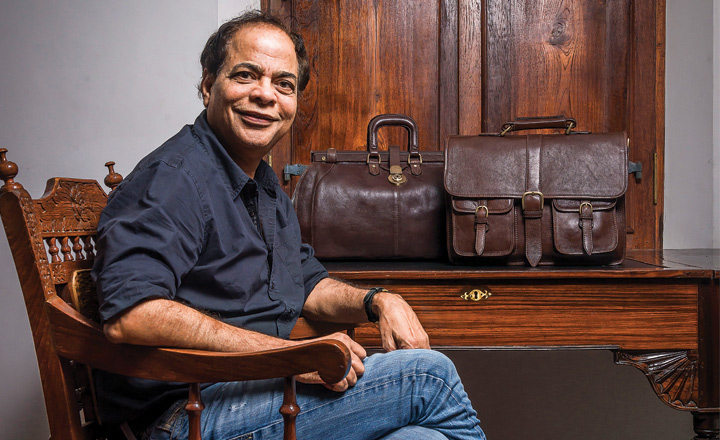As a long-haired undergrad at Princeton in the ’60s, Dilip Kapur, founder of luxury leather goods company Hidesign, was a self-avowed “idealist liberal” who “wanted to change the world”. “I was always at loggerheads with Steve Forbes (today the editor-in-chief of Forbes magazine), as he was always trying to push his conservative agenda,” says Dilip, in his company headquarters in a quaint heritage building in the town of Puducherry (formerly the French colony, Pondichéry). “It’s funny how I ended up a capitalist.”
Dilip, has deep roots in Auroville, the spiritual community founded by the Mother on Sri Aurobindo’s teachings, and located just a few kilometres from Puducherry. “My father sold his business when I was five and gave everything away to the ashram,” says Dilip, “Growing up, we had no radio, television, or telephone, just a fridge, so things, like air-conditioning and cars, still don’t matter to me. The Aurobindo school inculcated these values in me.”
After finishing high school at the Phillips Academy in Andover (he was the first Indian to study there), on a full scholarship, ultimately ending up with a PhD in international relations, Dilip started work at a company that imported leather known as East India leather from the UK, the best leather in the world. Upon his return to India, at the age of 30, he found out that the genesis of East India leather was some 150 km from his house in Puducherry! This was special leather, vegetable tanned, in a process that took 45 days (it takes around 25 days now). “Most leather today is chrome tanned,” says Dilip. “So we tied up back then with the family that was tanning the East India leather.” He also emphasizes that all of his leather is a by-product: it’s from an animal carcass killed for its meat. Today, his leather is imported from South Africa, Brazil, New Zealand, and Uganda – all countries with a thriving meat industry.
As he tied up with the leather supplier, Dilip began “poking” around with design, and constructing bags by hand. The very first bag he made (on the wooden desk that still sits in a charming room for guests at the famed Dupleix boutique hotel in White Town, that he owns), was the Castello, in 1971. He started with one worker, Murugan, an “illiterate genius” with a clean aesthetic. Dilip met a German politician who was visiting Auroville, who placed an order of 1,400 bags, his first order.
Then in the early ’80s, business boomed for Hidesign (Dilip has always supplied under his brand name). He was now retailing out of seven stores in the alternative and hip Castro District in San Francisco, where shops found his aesthetic, “weird” and different from the shiny bags available in department stores. The Castello and the Crossbody bags were big hits from the Icon collection. Fame struck suddenly, with Accessories magazine in the UK picking Hidesign’s Boxy bag as the Accessory of the Year. Dilip received the award in 1985 from Princess Diana of Wales, no less. “We didn’t think it was a big deal,” says Dilip. “By then I had 700 individual stores in London selling my bags. I was not retailing a single bag from India.” Even President Nelson Mandela became an aficionado of Hidesign, carrying the Andre bag. It was only in 2000 that Dilip Kapur entered the Indian market with their very first campaign. “That’s when I fell in love with India, and rediscovered it, after being abroad for so long,” says Dilip.
 Today, brand Hidesign (Louis Vuitton has a tiny stake in the company) manufactures around 22,000 bags and 25,000 wallets a month, from a red brick, organic factory around 10 km from town, that was set up 40 years ago, and designed by Dilip’s friend Ray (a potter from Berkeley, USA, who still lived in Auroville), using kiln-fired bricks. Surrounded by mangrove trees, filled with water bodies, it’s a calm oasis that hides the skilled artisanal work that goes on inside. This is where the leather is cut; bags are stitched, and brass buckles (Tanjore is nearby, so the best brass is from here) are made. Dilip’s son Vikas is selling the bags on Amazon Canada and Amazon USA, heading the brand’s e-commerce overseas.
Today, brand Hidesign (Louis Vuitton has a tiny stake in the company) manufactures around 22,000 bags and 25,000 wallets a month, from a red brick, organic factory around 10 km from town, that was set up 40 years ago, and designed by Dilip’s friend Ray (a potter from Berkeley, USA, who still lived in Auroville), using kiln-fired bricks. Surrounded by mangrove trees, filled with water bodies, it’s a calm oasis that hides the skilled artisanal work that goes on inside. This is where the leather is cut; bags are stitched, and brass buckles (Tanjore is nearby, so the best brass is from here) are made. Dilip’s son Vikas is selling the bags on Amazon Canada and Amazon USA, heading the brand’s e-commerce overseas.
Dilip’s latest line (he still heads the design team), the Atelier line, introduces exotic leather like ostrich and deer for the first time. “Ostrich skin from South Africa, is the most beautiful leather there is,” says Dilip. “It is natural and uses 3D shading from the raised quills.” So you have bags (that cost around `15,000), wallets, passport cases, mini bags, and then deer-leather laceups, and the softest wallets from the deer leather range. “It’s strong and light, but hard to make,” says Dilip. With gold-plated zinc metalware from China, each piece looks perfect. “We are giving a high-quality product, with real ostrich, deerskin, and suede,” says Dilip. “Our margins are not only a sixth of a European luxury brand, we are able to offer a product like this, that is handcrafted, at a very inexpensive price.” And that, is priceless.











